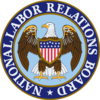An election is the most common way workers express their desire to form a new union. Some employers can be pressured (or are willing to) voluntarily recognize a union after a majority of workers affirm their support. However, the anti-union history of many employers in the U.S.-led to the passage of the National Labor Relations Act (NLRA) in 1935. The NLRA established the legal foundation for unionizing and collective bargaining in the US. The National Labor Relations Board (NLRB) enforces the NLRA, including the guidelines for union elections.
Here are the main steps for a union election through the NLRB:
Step 1: Filing with the NLRB
In order to compel an election, workers and/or union officials demonstrate a “showing of interest” by filing a petition or authorization cards with the regional office of the National Labor Relations Board. At least 30% of employees must have signed cards or a petition. The decision of when to file with the NLRB (and at what percentage) is an important strategic consideration. After filing, the regional board office will confirm that the workplace is in that regional office’s jurisdiction and that there is not already a union in place before proceeding towards an election.

Step 2: Election agreement
An election agreement authorizes the NLRB to conduct the election. The NLRB agent works with the parties to establish an election agreement that includes the date, time, place, and eligible voters. If no agreement is reached, the Board will hold a pre-election hearing.
Step 2.5 (if necessary): Pre-election hearing
Disputed issues can include union eligibility (eg: supervisory status) or community of interest (eg: the union may assert that all employees should be in one bargaining unit while the employer may argue that there should be multiple units based on different office locations or type of work performed).
The hearing can take days or weeks, depending on the number of disputed issues and the volume of information to review. The results of the hearing can be appealed by either party but the election will still proceed, even with challenged ballots. The timeframe of the election is determined in each agreement and can vary from a few days to a few weeks, depending on the workplace (using mail-in ballots necessitates a longer election period than in-person only).
The NLRB will direct an election to occur within a month after the conclusion of the hearing.
Step 3: Election begins
The employer is required to provide a list of eligible voters and mailing addresses (as well as email and phone number, if on file) and the union can check to make sure that every eligible voter receives their ballot to the correct address. Depending on the workplace, NLRB elections are held in-person ballot box at the primary work locations, by mail-in ballot, or a combination of mail and in-person (ie: in the event of a global pandemic all elections are conducted by mail).
Elections are conducted by paper ballot. Eligible voters will receive election materials by mail or in-person at the voting site. If in-person, the location of the vote will be determined and agreed upon in advance by both parties to ensure that people can vote in private and free from intimidation. The ballot gets sealed inside of a blank envelope which goes inside yet another envelope - this one has your name on it. Board agents ensure that only eligible voters cast ballots and that only one ballot is counted per voter. Completed ballots are either mailed or deposited in the on-site ballot box.
No one - including the Board agent - will know how you vote, but it will be known that you voted (or didn’t vote).

Step 3.5: Get out the vote (GOTV)
The vote is decided by a majority of ballots cast (not a majority of the total eligible voters). If only one person in a unit of 100 people casts a ballot, that single ballot will determine the outcome! The total number of ballots cast (the yes-no breakdown) will be public.
A strong yes vote shows a clear mandate and helps build momentum going into contract negotiations. Organizing committee members will stay in touch with co-workers 1:1 and will ask them directly how they plan to vote and if they have mailed the ballot back yet. Committees may also do a public “I’m Voting Yes” campaign and share quotes from coworkers who plan to vote yes or other public campaigns to build solidarity and momentum.
Management can hold “informational” meetings leading up to the election and can advocate for people to vote “No.” Employers have gone so far as to provide transportation to eligible voters. However, they can’t interrogate employees about their union support or attempt to sway votes by making threats or promises.
Don’t take any votes for granted - ask your colleagues how they plan to vote and turn out those yeses!
Step 4: Vote count
Once the election timeframe has concluded, an assigned NLRB board agent will count the votes at a designated date and time (typically within a few days, but sometimes weeks, after the conclusion of the vote). Vote counts are open to representatives of both the union and employer and held at an NLRB office or online (like Zoom).
The Board agent ensures that every ballot came from an eligible voter and that each person only voted once. The agent opens the blank envelopes as part of the vote count and identifies each as a yes or no vote. The process takes at least a few hours or more, depending on the size of the unit.
It can be nerve-racking to watch the vote count one ballot at a time, a strong GOTV effort helps with that!
Step 4.5 (if needed): Post-election hearing
Either party can object by filing for a post-election hearing within 7 days of the election. For example, either party could file a charge of voter intimidation or raise objections to a violation of the election agreement. A post-election hearing, when applicable, will take place within 21 days after the vote count.
Step 5: Certification
After a successful election, the NLRB certifies the union as the exclusive collective bargaining representative for unit employees. At this point, the employer has an obligation to bargain with the union in good faith and may be charged with an unfair labor practice, should they fail to do so.



